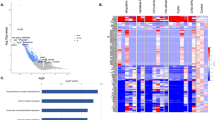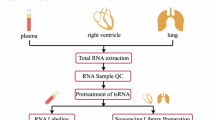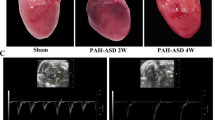Abstract
Animal models of pulmonary arterial hypertension (PAH) demonstrate up-regulation of the renin angiotensin system. However, no clinical data are available to support the efficacy of angiotensin II inhibition in treatment for PAH. In this mini review, we will update the knowledge regarding regulation of the RAS system in PAH compared to primary hypertension in order to seek better treatments against PAH.

Similar content being viewed by others
Pulmonary arterial hypertension (PAH) is defined by elevated pulmonary arterial pressure leading to right ventricular hypertrophy and dysfunction. Significant remodeling of the pulmonary vasculature, including medial hypertrophy and plexiform lesions leads to elevation of pulmonary arterial pressure [1]. The exact mechanism of pulmonary vasculopathy associated with PAH remains unclear [2]. Current PAH treatments target endothelin, nitric oxide, or the prostacyclin pathway [3]. However, incident patients have a 30% risk of death within 3 years [2]. Thus, novel knowledge regarding the molecular mechanism of pulmonary vascular remodeling is desired to develop better treatments against PAH.
There is evidence of increased activity of the renin-angiotensin system (RAS) in PAH patients [4]. However, no clinical data are available to support the efficacy of ACE inhibitors (ACEi) or angiotensin II receptor blockers (ARB) in treatment for PAH [5]. Understanding the alterations in the RAS activity associated with PAH may provide attractive therapeutic targets. In this mini review, we will update the knowledge regarding regulation of the RAS system in PAH compared to primary hypertension. In general, animal models of PAH show up-regulation of classical RAS such as ACE [6,7,8] and angiotensin II type 1 (AT1) receptor [9] as well as suppression of protective angiotensin converting enzyme 2 (ACE2) and angiotensin-(1–7) (Ang1-7) [6, 7, 10]. Table 1 indicates alterations in ACE, ACE2, Ang II and Ang1-7 expression or activity in various animal models of PAH. Mas receptor expression remains unchanged [8, 11]. AT1 receptor (AT1R) expression is increased in a hypoxic model of PAH [9]. There is no consensus on angiotensin II type 2 (AT2) receptor regulation in animal models of PAH [9, 12]. In primary hypertension, similar to PAH the alteration of RAS includes enhancement of classical RAS (ACE [13] and AT1 receptor [14, 15]) and down-regulation of the protective ACE2/Ang1-7 [14, 16, 17]. Regarding AT2 receptor, primary hypertension may upregulate AT2 receptor [18]. Mas receptor expression is unchanged [19]. Figure 1 summarizes overall changes in the RAS in animal models of primary hypertension and PAH.
RAS system dynamics under PAH vs. primary hypertension. Under PAH, increased ACE levels lead to more conversion of Ang I to Ang II [6, 7, 45]. Under PAH, ACE2 levels decrease [6, 7, 10], and Ang1-7 levels decrease [7] or remain unchanged [8, 11]. AT1 receptor (AT1R) expression is increased [9]. However, there is no consensus on AT2R regulation in PAH [9, 12]. Mas receptor (MasR) remains unchanged [8, 11]. Under primary hypertension (Hyp), ACE levels and the conversion of Ang I to Ang II also increase [13]. ACE2 levels decrease [14, 16, 17] and thus Ang1-7 levels decrease [13, 23]. In addition, AT1R expression is enhanced [14, 15]. AT2R may be upregulated [18]. MasR expression remains unchanged [19]
Several in vivo studies have shown that ACE2 protects against PAH [6, 7, 10, 11]. However, the alteration of RAS in PAH after ACEi or ARB treatment remains unknown. Animals with myxomatous mitral valve disease (MMVD) develop PAH. Dogs with MMVD were treated with ACEi or ARB to evaluate the RAS pathway [20]. Surprisingly, the authors found inhibition of ACE2 activity and the accompanying decline in Ang1-7 by ACEi, which may limit the cardioprotective effect of ACEi in PAH.
ACE2 converts Ang II to Ang1-7, a negative-regulator of the classical RAS [21]. In animal models of primary hypertension, ACEi and ARB either normalizes reduced ACE2 expression or increases it above control levels [13,14,15,16,17, 22,23,24,25]. Table 2 indicates changes in the RAS components in animal models of primary hypertension treated with ACEi or ARB. Up regulation of ACE2 is observed in many of these studies. This upregulation of ACE2 by ACEi/ARB is explained by their inhibitory effects on AT1 receptor. Ang II stimulation of AT1 receptor activates an integrin and metalloproteinase 17 (ADAM17), which cleaves and inactivates ACE2 [26]. Accordingly, plasma ACE2 appears increased in severe cases of cardiovascular diseases [27] as well as hypertension with heart failure in humans [28] potentially through inflammatory activation of ADAM17. However, in female rats with surgical menopause, ACEi led to a downregulation of the cardiac ACE2 expression [23]. In addition, several studies report that ARB upregulates ACE2 mRNA in animal models of hypertension [15, 16, 25]. In contrast, a few studies have shown that ARB does not change ACE2 mRNA abundance in various tissues such as kidney, lung and heart in mice [22, 24]. Accordingly, in animal models of primary hypertension, the effects of ACEi treatment on ACE2 appear inconsistent.
Regarding ARB effects on the RAS in PAH vs. primary hypertension, it was recently reported that ARB treatment significantly increased the plasma Ang II level in PAH dogs with MMVD [20]. In animal models of primary hypertension, ARB do not usually increase Ang II levels [22, 23, 29, 30]. ARBs may initially cause an increase in renin secretion due to the negative feedback, which could transiently increase Ang II levels. However, this is often counterbalanced by the increased conversion of Ang II to Ang1-7 [31, 32]. For instance, long-term treatment with an ARB, Olmesartan, has been shown to reduce Ang II levels, potentially through increased expression of ACE2 [33]. This modulation can lead to beneficial cardiovascular and renal effects [18].
To better understand the different RAS responses with treatment of ACEi or ARB in PAH vs. primary hypertension, it is important to mention the presence of local/tissue RAS including in the pulmonary system [34]. These local RAS could explain why ACEi and ARB have a different response in PAH compared with primary hypertension. The pulmonary RAS interplay with other pathways potentially contributing to PAH (dysregulation of the NO and prostacyclin pathways and activation of the endothelin pathway) might also explain the differences between systemic and pulmonary hypertension. The interaction between Ang1-7, NO and the endothelin pathway and its therapeutic implication has been demonstrated in hypoxia-induced animal model of pulmonary hypertension [35].
There are several reports testing the overexpression or administration of ACE2 in animal models of primary hypertension [36,37,38,39]. In Ang II-induced hypertension, transgenic rats expressing ACE2 in vascular smooth muscle cells significantly increased circulating levels of Ang1-7. Thus, the vasoconstrictive response to Ang II was weakened, resulting in a decrease in arterial blood pressure [38]. In addition, treatment with mouse recombinant ACE2 resulted in a significant increase in the conversion of Ang II to Ang1-7 [39].
In patients with PAH, systemic and pulmonary Ang II levels have been reported to be elevated [34], while serum ACE2 levels were decreased [40]. These clinical data suggest that in patients with PAH, administration of exogenous ACE2 may be a potential treatment.
Compared to normotensive individuals, in patients with primary hypertension, serum ACE2 concentrations were higher and significantly associated with left ventricular hypertrophy [41]. This contradictory increase in ACE2 seems to be compensatory to high blood pressure [21]. However, in one study treatment with ARB did not alter ACE2 levels in serum [42]. In addition, ACEi treatment in primary hypertension did not alter serum ACE2 levels [42, 43]. These results indicate variability in the impact of ACEi/ARB on ACE2 expression across different hypertensive populations.
In conclusion, the dynamics of RAS under ACEi or ARB administration appear to differ between PAH and primary hypertension. Although RAS activation is common to both PAH and primary hypertension, the effects of ACEi or ARB depend on the given context, which highlights the complexity of the RAS system regulation in cardiovascular disease. In PAH, ACEi may inhibit ACE2 activity and reduce Ang1-7. Thus, supplementing ACEi with ACE2 or Ang1-7 is an attractive treatment against PAH. Of note, it has been recently reported that significant numbers of PAH patients have primary hypertension [44]. Accordingly, further research is desired to explore the treatment of these populations with ACEi or ARB.
References
Hassoun PM. Pulmonary arterial hypertension. N Engl J Med. 2021;385:2361–76.
Spiekerkoetter E, Kawut SM, de Jesus Perez VA. New and emerging therapies for pulmonary arterial hypertension. Annu Rev Med. 2019;70:45–59.
Vazquez ZGS, Klinger JR. Guidelines for the treatment of pulmonary arterial hypertension. Lung. 2020;198:581–96.
Rosenkranz S, Howard LS, Gomberg-Maitland M, Hoeper MM. Systemic consequences of pulmonary hypertension and right-sided heart failure. Circulation. 2020;141:678–93.
Humbert M, Kovacs G, Hoeper MM, Badagliacca R, Berger RMF, Brida M, et al. 2022 ESC/ERS Guidelines for the diagnosis and treatment of pulmonary hypertension. Eur Respir J. 2022; https://doi.org/10.1183/13993003.00879-2022):2200879.
Yuan YM, Luo L, Guo Z, Yang M, Ye RS, Luo C. Activation of renin-angiotensin-aldosterone system (RAAS) in the lung of smoking-induced pulmonary arterial hypertension (PAH) rats. J Renin Angiotensin Aldosterone Syst. 2015;16:249–53.
Li G, Liu Y, Zhu Y, Liu A, Xu Y, Li X, et al. ACE2 activation confers endothelial protection and attenuates neointimal lesions in prevention of severe pulmonary arterial hypertension in rats. Lung. 2013;191:327–36.
Chen IC, Lin JY, Liu YC, Chai CY, Yeh JL, Hsu JH, et al. Angiotensin-Converting Enzyme 2 activator ameliorates severe pulmonary hypertension in a rat model of left pneumonectomy combined with VEGF inhibition. Front Med. 2021;8:619133.
Chassagne C, Eddahibi S, Adamy C, Rideau D, Marotte F, Dubois-Randé JL, et al. Modulation of angiotensin II receptor expression during development and regression of hypoxic pulmonary hypertension. Am J Respir Cell Mol Biol. 2000;22:323–32.
Hu HH, Zhang RF, Dong LL, Chen EG, Ying KJ. Overexpression of ACE2 prevents hypoxia-induced pulmonary hypertension in rats by inhibiting proliferation and immigration of PASMCs. Eur Rev Med Pharm Sci. 2020;24:3968–80.
Hampl V, Herget J, Bíbová J, Baňasová A, Husková Z, Vaňourková Z, et al. Intrapulmonary activation of the angiotensin-converting enzyme type 2/angiotensin 1-7/G-protein-coupled Mas receptor axis attenuates pulmonary hypertension in Ren-2 transgenic rats exposed to chronic hypoxia. Physiol Res. 2015;64:25–38.
Bruce E, Shenoy V, Rathinasabapathy A, Espejo A, Horowitz A, Oswalt A, et al. Selective activation of angiotensin AT2 receptors attenuates progression of pulmonary hypertension and inhibits cardiopulmonary fibrosis. Br J Pharm. 2015;172:2219–31.
Burrell LM, Gayed D, Griggs K, Patel SK, Velkoska E. Adverse cardiac effects of exogenous angiotensin 1-7 in rats with subtotal nephrectomy are prevented by ACE inhibition. PLoS ONE. 2017;12:e0171975.
Xia H, Feng Y, Obr TD, Hickman PJ, Lazartigues E. Angiotensin II type 1 receptor-mediated reduction of angiotensin-converting enzyme 2 activity in the brain impairs baroreflex function in hypertensive mice. Hypertension. 2009;53:210–6.
Whaley-Connell AT, Chowdhury NA, Hayden MR, Stump CS, Habibi J, Wiedmeyer CE, et al. Oxidative stress and glomerular filtration barrier injury: role of the renin-angiotensin system in the Ren2 transgenic rat. Am J Physiol Ren Physiol. 2006;291:F1308–14.
Takeda Y, Zhu A, Yoneda T, Usukura M, Takata H, Yamagishi M. Effects of aldosterone and angiotensin II receptor blockade on cardiac angiotensinogen and angiotensin-converting enzyme 2 expression in Dahl salt-sensitive hypertensive rats. Am J Hypertens. 2007;20:1119–24.
Zhong JC, Ye JY, Jin HY, Yu X, Yu HM, Zhu DL, et al. Telmisartan attenuates aortic hypertrophy in hypertensive rats by the modulation of ACE2 and profilin-1 expression. Regul Pept. 2011;166:90–7.
Mendoza-Torres E, Oyarzún A, Mondaca-Ruff D, Azocar A, Castro PF, Jalil JE, et al. ACE2 and vasoactive peptides: novel players in cardiovascular/renal remodeling and hypertension. Ther Adv Cardiovasc Dis. 2015;9:217–37.
Patel S, Hussain T. Dimerization of AT(2) and mas receptors in control of blood pressure. Curr Hypertens Rep. 2018;20:41.
Nair SK, Hersh EV, Margulies KB, Daniell H. Clinical studies in Myxomatous Mitral Valve Disease dogs: most prescribed ACEI inhibits ACE2 enzyme activity and ARB increases AngII pool in plasma. Hypertens Res. 2025;4:1477–90. https://doi.org/10.1038/s41440-025-02109-y.
Patel VB, Zhong JC, Grant MB, Oudit GY. Role of the ACE2/Angiotensin 1-7 Axis of the Renin-Angiotensin System in Heart Failure. Circ Res. 2016;118:1313–26.
Jessup JA, Gallagher PE, Averill DB, Brosnihan KB, Tallant EA, Chappell MC, et al. Effect of angiotensin II blockade on a new congenic model of hypertension derived from transgenic Ren-2 rats. Am J Physiol Heart Circ Physiol. 2006;291:H2166–72.
Sun X, Wang H, Hodge H, Wright KN, Ahmad S, Ferrario CM, et al. Amplifying effect of chronic lisinopril therapy on diastolic function and the angiotensin-(1-7) Axis by the G1 agonist in ovariectomized spontaneously hypertensive rats. Transl Res. 2021;235:62–76.
Iwanami J, Mogi M, Tsukuda K, Wang XL, Nakaoka H, Ohshima K, et al. Role of angiotensin-converting enzyme 2/angiotensin-(1-7)/Mas axis in the hypotensive effect of azilsartan. Hypertens Res. 2014;37:616–20.
Inaba S, Iwai M, Furuno M, Kanno H, Senba I, Okayama H, et al. Role of angiotensin-converting enzyme 2 in cardiac hypertrophy induced by nitric oxide synthase inhibition. J Hypertens. 2011;29:2236–45.
Lambert DW, Yarski M, Warner FJ, Thornhill P, Parkin ET, Smith AI, et al. Tumor necrosis factor-alpha convertase (ADAM17) mediates regulated ectodomain shedding of the severe-acute respiratory syndrome-coronavirus (SARS-CoV) receptor, angiotensin-converting enzyme-2 (ACE2). J Biol Chem. 2005;280:30113–9.
Narula S, Yusuf S, Chong M, Ramasundarahettige C, Rangarajan S, Bangdiwala SI, et al. Plasma ACE2 and risk of death or cardiometabolic diseases: a case-cohort analysis. Lancet. 2020;396:968–76.
Uri K, Fagyas M, Manyine Siket I, Kertesz A, Csanadi Z, Sandorfi G, et al. New perspectives in the renin-angiotensin-aldosterone system (RAAS) IV: circulating ACE2 as a biomarker of systolic dysfunction in human hypertension and heart failure. PLoS One. 2014;9:e87845.
Goldberg MR, Bradstreet TE, McWilliams EJ, Tanaka WK, Lipert S, Bjornsson TD, et al. Biochemical effects of losartan, a nonpeptide angiotensin II receptor antagonist, on the renin-angiotensin-aldosterone system in hypertensive patients. Hypertension. 1995;25:37–46.
Christen Y, Waeber B, Nussberger J, Porchet M, Borland RM, Lee RJ, et al. Oral administration of DuP 753, a specific angiotensin II receptor antagonist, to normal male volunteers. Inhibition of pressor response to exogenous angiotensin I and II. Circulation. 1991;83:1333–42.
Ferrario CM, Jessup J, Chappell MC, Averill DB, Brosnihan KB, Tallant EA, et al. Effect of angiotensin-converting enzyme inhibition and angiotensin II receptor blockers on cardiac angiotensin-converting enzyme 2. Circulation. 2005;111:2605–10.
Chen L, Kim SM, Eisner C, Oppermann M, Huang Y, Mizel D, et al. Stimulation of renin secretion by angiotensin II blockade is Gsalpha-dependent. J Am Soc Nephrol. 2010;21:986–92.
Agata J, Ura N, Yoshida H, Shinshi Y, Sasaki H, Hyakkoku M, et al. Olmesartan is an angiotensin II receptor blocker with an inhibitory effect on angiotensin-converting enzyme. Hypertens Res. 2006;29:865–74.
de Man FS, Tu L, Handoko ML, Rain S, Ruiter G, Francois C, et al. Dysregulated renin-angiotensin-aldosterone system contributes to pulmonary arterial hypertension. Am J Respir Crit Care Med. 2012;186:780–9.
Montezano AC, Kuriakose J, Hood KY, Sin YY, Camargo LL, Namkung Y, et al. Ang-(1-7) and ET-1 Interplay Through Mas and ET(B) Receptor interaction defines a novel vasoprotective mechanism. Hypertension. 2025;82:267–81.
Sriramula S, Cardinale JP, Lazartigues E, Francis J. ACE2 overexpression in the paraventricular nucleus attenuates angiotensin II-induced hypertension. Cardiovasc Res. 2011;92:401–8.
Wysocki J, Ye M, Rodriguez E, González-Pacheco FR, Barrios C, Evora K, et al. Targeting the degradation of angiotensin II with recombinant angiotensin-converting enzyme 2: prevention of angiotensin II-dependent hypertension. Hypertension. 2010;55:90–8.
Rentzsch B, Todiras M, Iliescu R, Popova E, Campos LA, Oliveira ML, et al. Transgenic angiotensin-converting enzyme 2 overexpression in vessels of SHRSP rats reduces blood pressure and improves endothelial function. Hypertension. 2008;52:967–73.
Ye M, Wysocki J, Gonzalez-Pacheco FR, Salem M, Evora K, Garcia-Halpin L, et al. Murine recombinant angiotensin-converting enzyme 2: effect on angiotensin II-dependent hypertension and distinctive angiotensin-converting enzyme 2 inhibitor characteristics on rodent and human angiotensin-converting enzyme 2. Hypertension. 2012;60:730–40.
Dai HL, Guo Y, Guang XF, Xiao ZC, Zhang M, Yin XL. The changes of serum angiotensin-converting enzyme 2 in patients with pulmonary arterial hypertension due to congenital heart disease. Cardiology. 2013;124:208–12.
Li S, Wang Z, Yang X, Hu B, Huang Y, Fan S. Association between circulating angiotensin-converting enzyme 2 and cardiac remodeling in hypertensive patients. Peptides. 2017;90:63–8.
Emilsson V, Gudmundsson EF, Aspelund T, Jonsson BG, Gudjonsson A, Launer LJ, et al. Antihypertensive medication uses and serum ACE2 levels: ACEIs/ARBs treatment does not raise serum levels of ACE2. medRxiv. 2020. https://doi.org/10.1101/2020.05.21.20108738.
Úri K, Fagyas M, Kertész A, Borbély A, Jenei C, Bene O, et al. Circulating ACE2 activity correlates with cardiovascular disease development. J Renin Angiotensin Aldosterone Syst. 2016;17:1470320316668435.
Itelman E, Segel MJ, Kuperstein R, Feinberg M, Segev A, Segal G, et al. Pulmonary hypertension is associated with systemic arterial hypertension among patients with normal left ventricular diastolic function. J Am Heart Assoc. 2021;10:e023603.
Dang Z, Su S, Jin G, Nan X, Ma L, Li Z, et al. Tsantan Sumtang attenuated chronic hypoxia-induced right ventricular structure remodeling and fibrosis by equilibrating local ACE-AngII-AT1R/ACE2-Ang1-7-Mas axis in rat. J Ethnopharmacol. 2020;250:112470.
Author information
Authors and Affiliations
Corresponding author
Ethics declarations
Conflict of interest
The authors declare no competing interests.
Additional information
Publisher’s note Springer Nature remains neutral with regard to jurisdictional claims in published maps and institutional affiliations.
Rights and permissions
Springer Nature or its licensor (e.g. a society or other partner) holds exclusive rights to this article under a publishing agreement with the author(s) or other rightsholder(s); author self-archiving of the accepted manuscript version of this article is solely governed by the terms of such publishing agreement and applicable law.
About this article
Cite this article
Nakayama, Y., Eguchi, S. The renin-angiotensin system in models of pulmonary arterial hypertension vs primary hypertension. Hypertens Res 48, 2522–2526 (2025). https://doi.org/10.1038/s41440-025-02299-5
Received:
Revised:
Accepted:
Published:
Issue date:
DOI: https://doi.org/10.1038/s41440-025-02299-5




